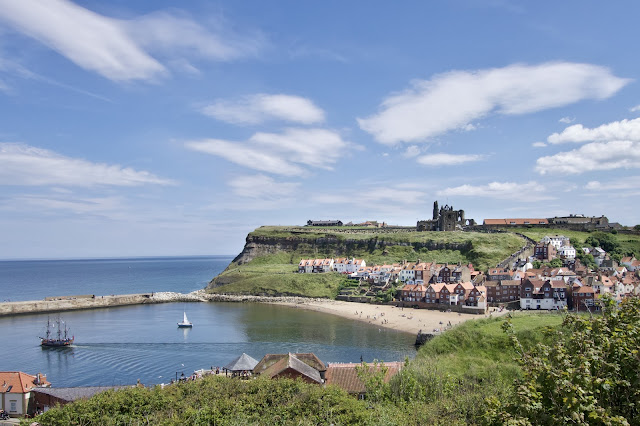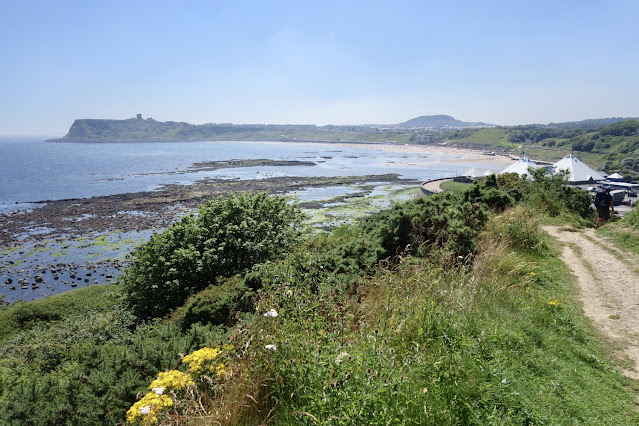Goathland and Sneaton High Moor (North York Moors)
The North York Moors was the destination for our first walk
of 2014. It was a cold but dry weekend
and not too windy when we left home, although up on the moors the wind always
blows more strongly than on the lower ground.
There had been a frost so we thought perhaps it wouldn't be too soggy
underfoot. At this time of year though it's probably best to forget about
keeping your boots clean!
I had just treated myself to a Garmin Etrex 20 GPS in the
January sales and wanted to test it out with an eleven mile circular walk which I had devised and plotted. Like all new gadgets, it
was all a bit confusing to begin with but overall I think I managed quite
well. And so, from now on, as well as
writing a general blog about a walk, I'm also going to try my hand at providing
a route map and description.
The start and finishing point for this walk is the moorland
village of Goathland, famous for its role as Aidensfield in the once popular
television series "Heartbeat".
This isn't a programme I ever watched, but even though the series
finished some years ago the village still attracts fans and maintains many of
the fictional Aidensfield's landmarks such as the general store, the garage,
funeral directors and pub. In the summer
months several vehicles from the Sixties are parked strategically around the
village, including an old Ford Anglia "panda" police car. There was no sign of vintage cars, or
tourists, as we drove into the village and parked in an unusually empty car
park.
Our route began by turning left out of the main village car
park and crossing a bridge to the railway station. All was quiet here too, although in the
tourist season the station would be bustling with passengers waiting for steam trains
on the North York Moors Railway which runs between Pickering and
Grosmont/Whitby. It's an attractive
little station which was used in the Harry Potter movies as Hogsmeade
Station. In fact, sections of the North
York Moors railway were used to film Harry's train journeys to Hogwarts.
Goathland Station
At the station we crossed the line and turned right to climb
up a steep bank which gave us a view down over the station buildings.
Looking down on Goathland Station
From above the station we followed a path which after a
short distance ended by a country lane where we turned left and then walked
uphill for a short while before turning right onto a track which led over a
stream, passed farm buildings and then out onto a patch of open moorland.
Moorland above Goathland
We followed this track for a mile or so before it joined the
road into Goathland from the A169. There
then followed a stretch of road walking, climbing gradually away from Goathland
and offering excellent views over the surrounding countryside and across to
Fylingdales Early Warning Station.
Across the moors to Fylingdales
RAF Fylingdales is a radar base and it is also part of the
ballistic missile early warning system, shared between the UK and the USA. During the Cold War RAF Fylingdales would have
been responsible for the "four minute warning". I'm not sure if it still is today - it's not
something I really like to think about!
The massive pyramid structure, which is visible in the landscape for
miles around, is actually a group of radars which can cover a complete 360
degrees. As well as providing the early
warning system, Fylingdales also tracks orbiting objects in space.
Continuing along the lane we eventually reached the busy
A169 Pickering to Whitby road, turning right and walking to where it bends
sharply at the bridge over Eller Beck.
The road was very busy and
extreme caution was needed when crossing the bridge as there's no footpath and
judging by the amount of debris and paint marks on the masonry, passing traffic
can get a bit too close!
Thankfully, immediately after crossing Eller Beck Bridge a
public footpath is visible heading off to the left onto the open moorland. There then follows something of a slog over
poorly defined paths which, on the day we walked, were waterlogged, frozen and
very muddy in places. The path passes
quite close to the Fylingdales radar base which seemed to emit a constant sound
like a huge fan turning, or perhaps wind hitting a cliff. I couldn't decide whether the radar itself
made the noise, or the wind passing over it.
Finding a path through the mud, ice and puddles
Eventually my focal point for this particular walk came into
sight on the higher ground ahead. This
is Lilla Cross, one of the oldest Christian relics in Britain. It purportedly marks the spot where in 626 AD
King Edwin of Northumbria was saved from an assassin's poisoned sword by a
priest named Lilla who leapt forward and took the fatal blow. King Edwin was so grateful he is supposed to
have had this cross erected in Lilla's memory and also a few months later, at Easter 627 AD in York, the previously
pagan Edwin converted to Christianity. After his death at the battle of Hatfield in
633 AD his queen, Ethelburga, became the first Anglo Saxon queen to take the
veil, living as Abbess of Lyming until her death, and later becoming Saint Ethelburga
(I mention this because there's a connection here to my next walk). Incidentally, King Edwin was considered a
great ruler in his time, bringing peace between Northumbria and the Scots
resulting in the creation of the town of Edwin's Borough, known today as the
city of Edinburgh.
Lilla Cross
Lilla Cross marked the turning point of our walk, back
towards Goathland. It was also a
convenient place to eat our packed lunch, although being on quite high ground
it was not a place to hang around for long in the biting January wind. Our path headed north west from Lilla Cross
over Sneaton High Moor and passing another moorland cross - Ann's Cross which
sits on top of a tumulus. This isn't a
cross as such, but it does have a cross carved upon it, along with what appears
to be a large letter 'C'. I have yet to
be able to find out any detailed information about this particular standing
stone, although it may be a waymarker for an old pannierman's way.
Ann's Cross
The track led us all the way back to the A169 and, having
left the moor, we turned right for a hundred yards or so and then crossed over
to follow a quiet country lane, downhill all the way back to Goathland. It was just before 5 p.m. when we returned to
the village which was in complete darkness and very quiet, except for the sound
of an owl hooting in the trees by the car park.
All the coffee shops and pubs were closed and our car was all on its own
in the car park. It felt like the dead
of night, not just teatime!
Below is a copy of the map for this walk. The little blue flags are apparently
waypoints - I'm still getting to grips with using GPS! If there's sufficient interest, and if I can
figure out how to do it, I may be able to include downloadable GPX files in the
future. As always, I'd be happy to
answer any questions or provide any additional details if required.
The route for this walk











Comments
Post a Comment